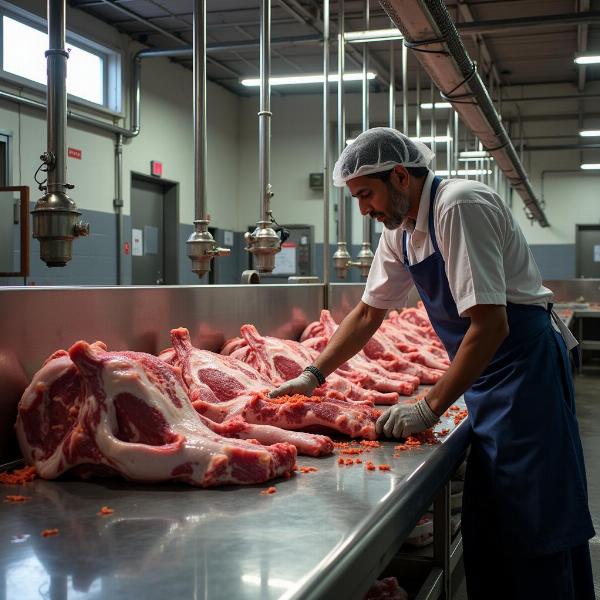Understanding the meaning of “abattoir” in Hindi is crucial for anyone involved in the meat processing industry, legal documentation related to animal slaughter, or simply expanding their Hindi vocabulary. While the direct translation isn’t always straightforward, grasping its nuances can provide valuable insights into Indian culture and language. This article will delve into the various Hindi terms used for “abattoir,” explore their cultural context, and provide practical examples to solidify your understanding.
What Does “Abattoir” Mean in Hindi?
The English word “abattoir” refers to a slaughterhouse, a facility where animals are killed for consumption. In Hindi, several terms convey this meaning, each with slightly different connotations. The most common terms include कसाईखाना (kasai khana), literally “butcher’s house,” and वधशाला (vadhshala), which translates to “slaughterhouse.” Other less common terms include कत्लगाह (katlgah), meaning “place of slaughter,” and मांस का कारखाना (mans ka karkhana), “meat factory.” While these words all refer to the same general concept, their usage can vary depending on regional dialects and specific contexts.
Understanding the Cultural Context of “Abattoir” in India
The concept of an abattoir holds significant cultural and religious weight in India. With a diverse population adhering to various dietary practices, including vegetarianism and specific religious restrictions on meat consumption, the slaughter of animals is a sensitive subject. Understanding these cultural nuances is crucial for navigating conversations and written materials related to this topic. For instance, the term vadhshala often carries a more formal and sometimes religious connotation, often used in official documents or discussions about animal welfare. In contrast, kasai khana is a more colloquial term, commonly used in everyday conversations.
Different Terms for “Abattoir” in Hindi and Their Usage
-
कसाईखाना (Kasai khana): This is the most commonly used and easily understood term. It directly refers to a place where a butcher works and slaughters animals.
-
वधशाला (Vadhshala): This term is often used in official contexts and has a slightly more formal tone. It is commonly used in legal documents, government regulations, and news reports.
-
कत्लगाह (Katlgah): This term emphasizes the act of slaughtering and can sometimes carry a negative connotation due to its association with violence.
-
मांस का कारखाना (Mans ka karkhana): This term emphasizes the industrial aspect of meat production and is often used to refer to large-scale meat processing facilities.
 Modern Abattoir in India
Modern Abattoir in India
Using “Abattoir” Terms in Sentences
Here are some examples of how these terms can be used in sentences:
- गांव के पास एक कसाईखाना है। (Gaon ke paas ek kasai khana hai.) – There is a butcher shop near the village.
- सरकार ने नई वधशाला के निर्माण को मंजूरी दी है। (Sarkar ne nayi vadhshala ke nirman ko manjoori di hai.) – The government has approved the construction of a new abattoir.
Common Questions about “Abattoir” in Hindi
-
What is the most polite way to refer to an abattoir in Hindi? Using vadhshala is generally considered more polite and formal than kasai khana.
-
Are there any regional variations in the terms used for “abattoir”? Yes, regional dialects may use different terms, but kasai khana and vadhshala are widely understood across India.
Conclusion
Understanding the different Hindi terms for “abattoir” and their cultural context is crucial for effective communication. While kasai khana and vadhshala are the most common and widely understood terms, knowing the nuances of other terms like katlgah and mans ka karkhana can provide a deeper understanding of the language and its cultural implications. This knowledge is especially important for those working in related industries or engaging in discussions about food and cultural practices in India.
FAQs
- What is the difference between kasai khana and vadhshala? Kasai khana is more colloquial, while vadhshala is more formal.
- Is katlgah a commonly used term? It’s less common than kasai khana and vadhshala and can have a negative connotation.
- Which term is suitable for official documents? Vadhshala is preferred for official and formal contexts.
- What does mans ka karkhana refer to? It refers to a large-scale meat processing factory.
- Why are there multiple terms for “abattoir” in Hindi? The varied terms reflect the diverse cultural and linguistic landscape of India.
Related Articles
About Meaning-Hindi.in
Meaning-Hindi.in is your premier resource for professional Hindi translation services. We specialize in a wide range of translation needs, from business and legal documents to technical manuals and website localization. Our team of expert linguists ensures accurate and culturally sensitive translations to bridge the communication gap between Hindi and other languages. Need a document translated quickly and accurately? Contact us today at [email protected] or call us at +91 11-4502-7584. Meaning-Hindi.in is your trusted partner for all your Hindi translation needs.